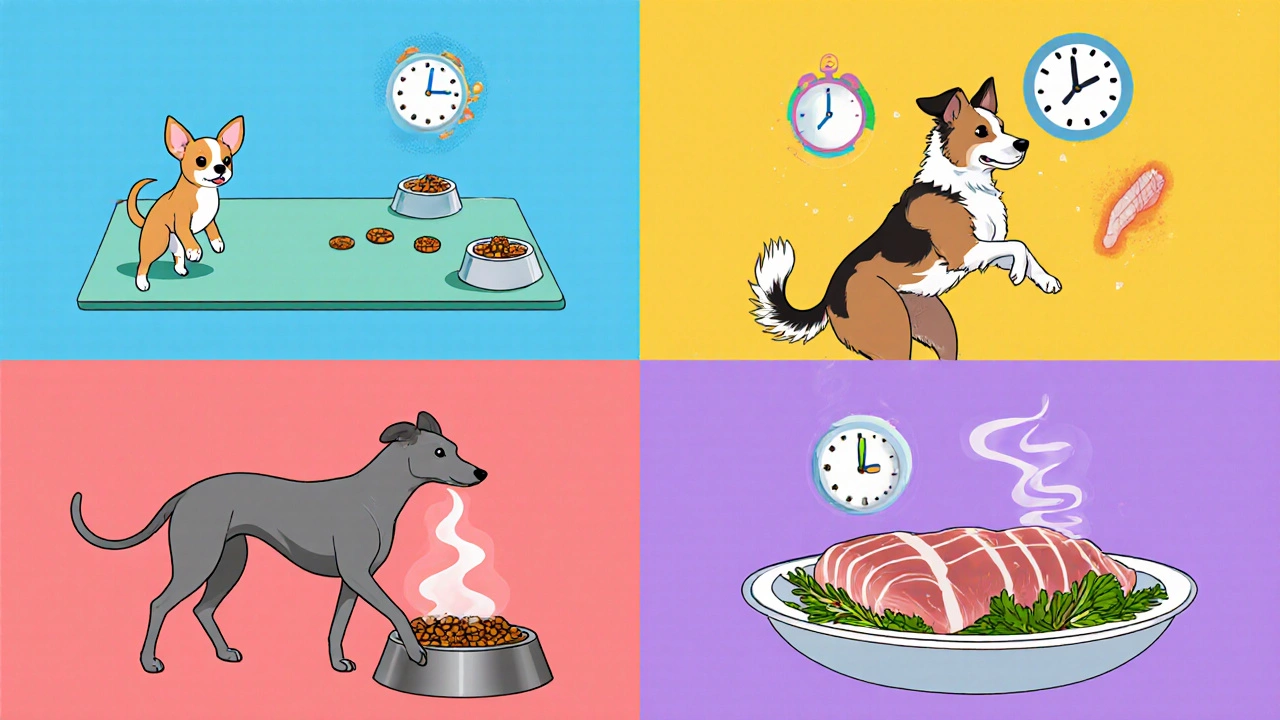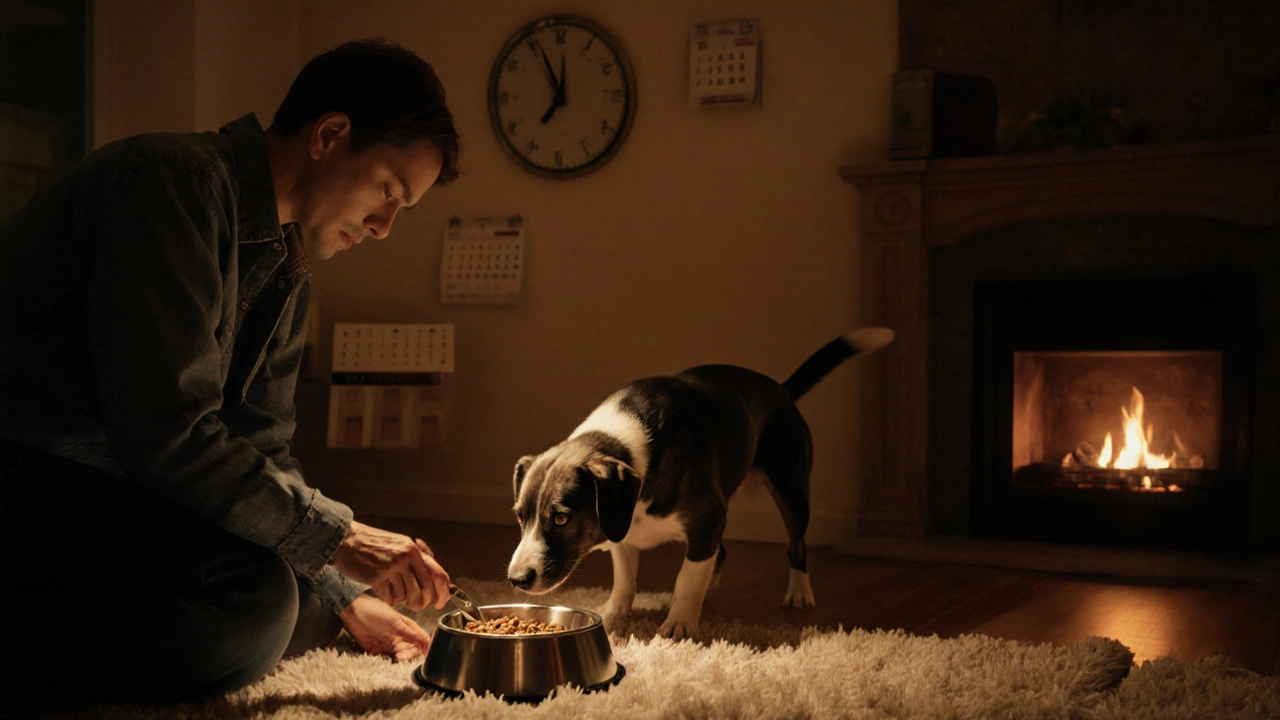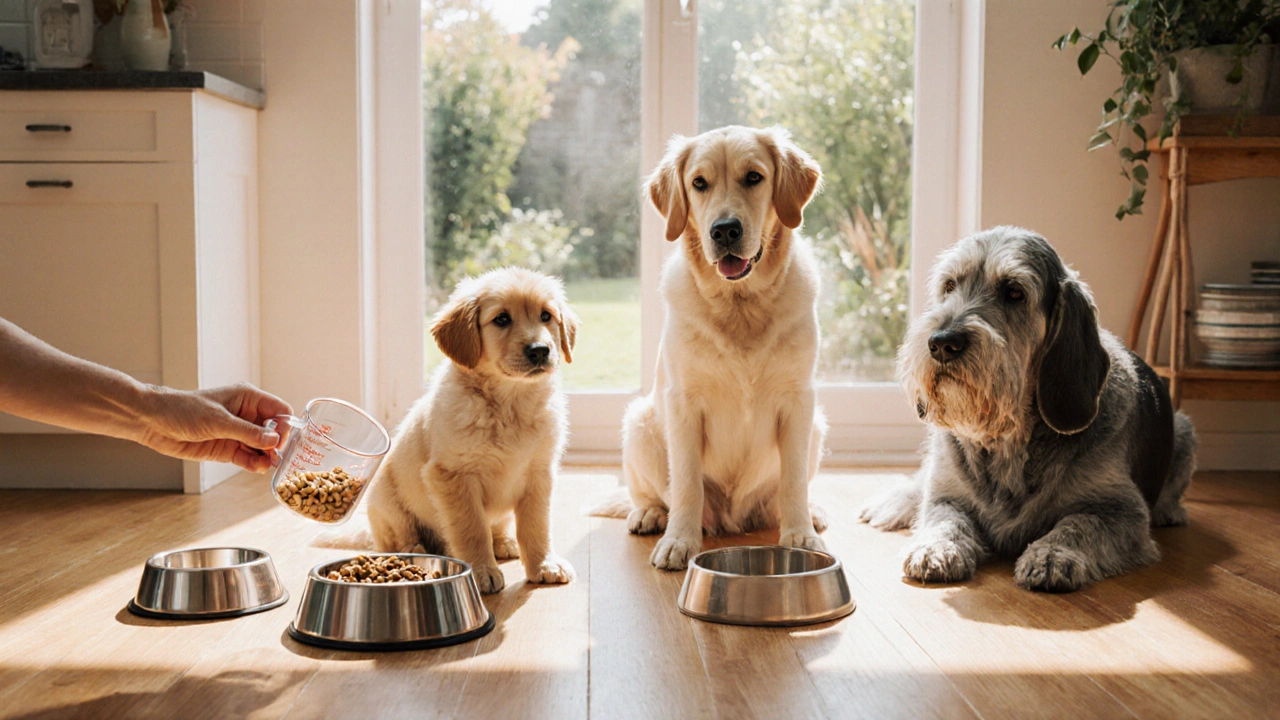Dog Feeding Calculator
Enter your dog's information to see their optimal feeding plan.
When it comes to keeping a dog happy and healthy, dog feeding frequency is one of the first questions new owners ask. Feeding a dog the right number of times each day isn’t just about filling a bowl; it’s about matching meals to a pet’s age, size, activity level, metabolism, and the type of food you give. Getting it right helps maintain a steady energy level, supports proper digestion, and can prevent weight‑related problems later on.
Why Feeding Frequency Matters
Dogs, unlike humans, have a shorter digestive tract and a faster metabolism. This means they process food more quickly and can benefit from multiple smaller meals instead of one large serving. Feeding too infrequently can cause blood‑sugar dips, leading to lethargy or irritability, while overeating in one sitting can overload the stomach and increase the risk of bloating, especially in deep‑chested breeds.
Core Factors That Drive the Ideal Schedule
Before deciding how many times a day to feed, consider these five key variables:
- Dog age - puppies, adults, and seniors each have distinct nutritional needs.
- Dog size - small, medium, large, and giant breeds differ in stomach capacity and calorie requirements.
- Activity level - a couch‑potato hound versus a working retriever burns vastly different amounts of energy.
- Metabolism - fast‑metabolizing dogs may need more frequent feedings to keep energy steady.
- Dog food type - dry kibble, wet food, raw, or home‑cooked meals each have different satiety profiles.
These elements interact, so a one‑size‑fits‑all rule won’t work. Below is a practical framework that helps you line up the variables with a feeding schedule.
General Guidelines by Life Stage
Here’s a quick reference you can use as a starting point. Adjust based on the factors above and your veterinarian’s advice.
| Life Stage | Recommended Meals per Day | Why It Works |
|---|---|---|
| Puppies (8weeks-6months) | 3-4 | Rapid growth needs steady calories and nutrients. |
| Adolescent puppies (6months-12months) | 2-3 | Still growing but can handle slightly longer gaps. |
| Adult dogs (1-7years) | 2 | Stable metabolism; two meals keep blood‑sugar even. |
| Senior dogs (7+years) | 2-3 | Older dogs may benefit from smaller, more frequent meals for easier digestion. |
These numbers are averages. A high‑energy Border Collie may thrive on two larger meals, while a small, low‑activity Chihuahua might feel better with three tiny portions.
Tailoring the Schedule to Size and Activity
Let’s break down how size and activity modify the baseline.
- Small breeds (under 20lb) - Their stomachs hold less food, so dividing the daily calorie goal into three meals can prevent gulp‑down behavior and reduce the chance of hypoglycemia.
- Medium breeds (20‑50lb) - Most owners find two meals per day work well. If the dog is very active, a third snack‑size meal after intense play can help.
- Large & giant breeds (over 50lb) - Two meals are common, but split the portions if the dog shows signs of gastrointestinal upset after big meals.
- High‑energy dogs (working, sporting, or very active) - Consider 2.5 meals: a standard breakfast, a larger lunch, and a light evening snack. The snack can be a handful of kibble or a low‑calorie treat.
- Low‑energy or overweight dogs - Stick to two meals and measure portions carefully. Avoid free‑feeding (leaving food out all day).
Pay attention to your pup’s behavior after meals. If you notice gulping, begging, or a boomy belly, you might need to split the portions more finely.

Impact of Food Type on Meal Frequency
The kind of food you serve influences how long a dog feels full.
- Dry kibble is low in moisture and tends to digest quickly, so active dogs on kibble often benefit from two solid meals plus a midday snack.
- Wet food contains more water, which can increase satiety. Some owners find a single, larger wet‑food meal works for senior dogs, but most still split it into two.
- Raw or home‑cooked diets are higher in protein and fat, often leading to longer digestion times. Two meals per day are usually sufficient, but monitor weight closely.
Whatever you feed, always calculate the total daily calories and then divide by the number of meals you plan to serve.
Calculating Daily Calorie Needs
Here’s a quick formula many vets use:
Resting Energy Requirement (RER) = 70 × (body weight in kg)^0.75
Multiply the RER by a factor that reflects activity level:
- 1.2-1.4 for neutered adult dogs (low activity)
- 1.5-1.8 for active, working, or growing dogs
- 1.0-1.2 for senior or less active dogs
For example, a 20‑lb (9kg) moderately active adult dog would need:
RER = 70 × 9^0.75 ≈ 370kcal
Daily calories = 370 × 1.6 ≈ 590kcal
Divide that 590kcal by the number of meals you’ve chosen. If you feed twice, each meal is about 295kcal; if three times, about 195kcal per meal.
Practical Steps to Set Up a Feeding Routine
- Determine your dog’s life stage, size, and activity level.
- Calculate the daily calorie target using the RER formula.
- Choose a feeding frequency based on the guidelines above.
- Measure the exact amount of food for each meal using a kitchen scale or a calibrated cup.
- Serve meals at consistent times each day - breakfast around 7am, dinner around 6pm works for most households.
- Observe your dog for 1-2 weeks: watch for weight changes, energy dips, or digestive upset.
- If needed, adjust portion size or add a snack‑size third meal. Consult a Veterinarian if you’re unsure.
Consistency is key. Dogs thrive on routine; they’ll quickly learn when food is coming and feel more secure.

Common Mistakes and How to Avoid Them
- Free‑feeding - Leaving kibble out all day makes it impossible to control calories and can lead to obesity.
- Skipping meals for “training” - Withholding food to correct behavior can cause stress and metabolic issues.
- Using human table scraps as a regular snack - Even small amounts of high‑fat foods can upset the calorie balance.
- Not adjusting for life‑stage changes - Puppies grow fast; seniors slow down. Re‑evaluate the schedule every 6 months.
- Ignoring breed‑specific risks - Giant breeds are prone to gastric dilatation‑volvulus (bloat); feeding them smaller, more frequent meals can reduce risk.
By staying aware of these pitfalls, you’ll keep your dog’s weight in check and their tummy happy.
When to Seek Professional Advice
If you notice any of the following, book a check‑up:
- Sudden weight loss or gain despite consistent feeding.
- Persistent vomiting, diarrhea, or excessive gas after meals.
- Signs of hypoglycemia - weakness, shaking, or collapse, especially in small breeds.
- Older dogs that have trouble chewing or swallowing.
A qualified veterinarian can tailor a feeding plan that accounts for medical conditions like diabetes, kidney disease, or allergies.
Quick Reference Checklist
- Identify life stage, size, activity level.
- Calculate daily calories (RER × activity factor).
- Choose 2-3 meals per day based on guidelines.
- Measure each meal precisely.
- Feed at the same times each day.
- Monitor weight and energy, adjust as needed.
- Consult a veterinarian for any concerns.
Frequently Asked Questions
Can I feed my dog only once a day?
Most adult dogs do well on two meals, but feeding just once a day can cause blood‑sugar spikes and increase the risk of bloat in large, deep‑chested breeds. If you must feed once, choose a low‑fat, easily digestible diet and monitor closely.
Do puppies need more than three meals a day?
Very young puppies (8‑12weeks) often thrive on three to four small meals. Their tiny stomachs can’t hold a full adult portion, and frequent feedings keep energy steady for rapid growth.
Should I change the feeding schedule when I switch food types?
Switching from dry kibble to wet or raw often increases satiety. You may be able to reduce the number of meals, but keep total calories the same. Gradually transition over a week and watch for digestive changes.
My senior dog seems hungry between meals. What should I do?
Add a low‑calorie snack such as a few pieces of baby carrots or a small spoon of plain pumpkin. Keep the snack under 10% of daily calories to avoid weight gain.
Is it okay to feed my dog at irregular times if my schedule changes?
Occasional variation is fine, but try to keep a rough 12‑hour gap between meals. Frequent irregularity can confuse digestion and lead to anxiety about food.
